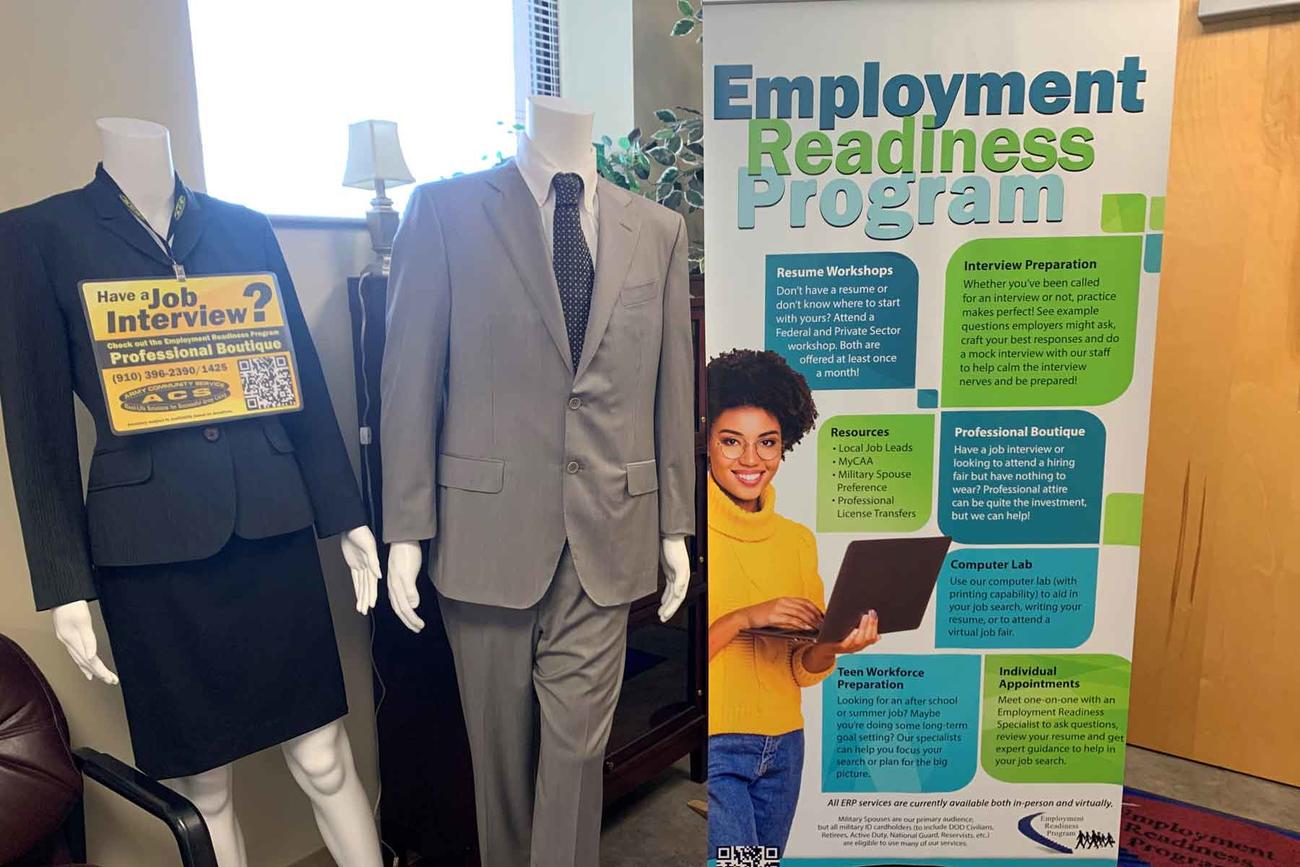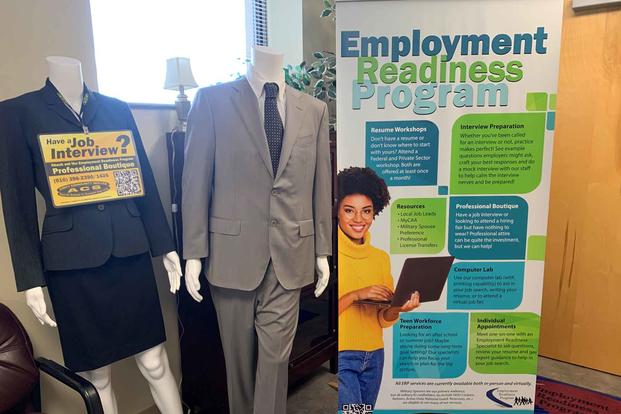

Jennifer Barnhill is a columnist for Military.com writing about military families.
The steady military spouse 21% unemployment rate somehow still makes headlines despite being a documented problem since the 1970s. We don’t often read about the 36% of military spouses who are out of the workforce entirely. The often-ignored truth is that military spouses are out of the workforce at statistically higher rates than their civilian counterparts, but no one talks about it because it is seen as a “choice.”
Army spouse Elizabeth Mays was relieved that her husband was going to be able to be there for the birth of their child. He was about to deploy, so they knew there was no guarantee he would be able to be there for this important family moment. But her relief was short-lived when she started to sort through the logistics of staying in the workforce herself.
“We did the math, and I would be paying them $50 a week essentially to work there,” given child care costs, said Mays. “And so that was a decision. It just doesn’t make sense. I’m going to have a newborn. I’m going to be commuting an hour. … It was five years later that I looked to reenter the workforce.”
Although the Mays family weighed their options and Elizabeth “chose” to exit the workforce, her story highlights a level of nuance about the decisions military spouses make that the military community often glazes over.
“When we talked to military spouses, they kind of felt like they didn’t have much of a choice,” John Sawyer, director for education, workforce and income security for the Government Accountability Office, told Military.com in a May interview. “Either they wouldn’t, could not work at all or work part-time, just based on the challenges they faced.”
The GAO recently released a report diving into the experiences of military spouses who choose to work part-time.
“About 23% said they worked part-time because they wanted to spend time with their children. About 16% said they can only find part-time work; 12% said they face child care problems,” said Sawyer, citing findings from the DoD’s 2019 Survey of Active Duty Spouses that informed the GAO’s report.
Over the years, I have spoken to many military spouse parents who “choose” to work part-time or remain out of the workforce to create stability for their children. While many spouses do remain out of the workforce as their children get older, most make this “choice” when their kids are young and child care is more expensive and elusive. The 2019 survey confirms these stories. Parents of children under six years old were more likely to report “wanting to stay home with kids” (41%) and experiencing “child care problems” (25%) as their reason for working part-time. Respondents with older children had fewer child care “problems,” which makes sense. Older kids are in school half the day and can attend school-provided before- and after-care. Parents of older children have more “choices” available to them.
But what about spouses without children? It turns out their lack of choice is laid bare. They work part-time because they “could only find part-time work” (27%).
“We don’t have children yet,” said Heba Abdelaal. “When we talk about military spouse employment, the very first and maybe only challenge that is presented is, ‘Well, child care is the main or primary issue.’… But again, not having children yet, that wasn’t exactly the primary barrier that I experienced to employment. It was actually the fact that we’re overseas.”
And Abdelaal is not the only one whose workforce status was influenced by more than parenting. Before I married my husband, I was working at the Smithsonian and had been offered a full scholarship to obtain my Ph.D. in art history. I had big plans to edit a museum magazine and fact-check scholarly journals in Italy. I quickly realized that I would not be able to find a job in my field if I were to have no control over where we lived. Like many career fields, mine was one where you go where the job is and work your way up a slow-moving ladder. Because my husband couldn’t quit the military, I “chose” to decline the scholarship and move to Pensacola, Florida, where he was in flight school.
I couldn’t pursue my dream job and we didn’t have kids, so we were free to “choose” to have an adventure and move outside of the continental U.S. to Atsugi, Japan. On paper, it was absolutely my choice to risk being out of the workforce during this time, a period before remote work was a possibility. After Japan, we had no choice. We were told to go to Fallon, Nevada — an employment desert — where I was offered insultingly low salaries because “military spouses didn’t need to pay for their own rent or health care.”
While I eventually found a great job, it was a job, not a career.
We “chose” to go back to Japan because, by then, I had one toddler and was pregnant with our second child as we approached our permanent change of station move. I knew finding a new job and affordable child care while six months pregnant would be next to impossible, so I “chose” to be out of the workforce again.
At every turn, my “choice” to be out of the workforce or be underemployed was a direct result of the confluence of military lifestyle factors I’m forced to consider as I make “choices” for my career and life.
If my husband and I did not have to move due to his military career, I would have chosen to pursue a job within my field. I would have had kids but been in my roles long enough to have legal protections to be able to return to work and have the opportunity to invest in my retirement savings. I may not have had the amazing adventures from both tours in Japan, but the ability to pursue a professional career would have been more of a choice.
But because these decisions to work part-time or not work are seen as choices, we know very little about them. Although surveys ask surface-level questions, the deep dives are not often widely reported. The 2019 Survey of Active Duty Spouses asked military spouses why they were not looking for work (out of the workforce) and presented spouses with 16 responses including, “I do not want to work;” “I cannot find any work that matches my skills;” and “I want to be able to stay home to care for my children.”
Like part-time working military spouse parents, those who were not looking for work cited wanting to stay home with their children (41%).
The No. 1 reason military spouses without children said they were not looking for work was “Other” at 28%.
As a researcher, when I see “other” as the most commonly selected choice, I assume one of two things. Either the population being surveyed is so diverse that a consensus is unlikely or the survey question was poorly constructed. While both are possible, it is hard not to notice an obvious choice that was omitted — the demands the military places on military families, namely service members’ unpredictable work schedules and deployments.
These demands are what Nobel Prize winner Claudia Goldin calls “greedy” work. Her research looks at how highly demanding jobs force couples to negotiate equity within their family unit. If jobs are predictable and are limited to 40 hours a week, the “couple’s equity” has the potential to be balanced. But “greedy” professions like law and medicine require individuals to climb demanding career ladders working overtime, throwing the couple’s equity off balance. Unlike civilian greedy professions that dangle high salaries and perks, the military does not pay service members enough to cover 24/7 child care or housekeeping and food preparation services, things that help rebalance a dual working couple’s equity. As a result, military spouses “choose” to work part-time, outside their field or not at all, and they do so at significantly higher rates than civilians.
According to research from the Brookings Institution, 18% of Americans aged 25 to 54 were out of the workforce in 2016; 70% were women and 30% were male. In 2017, the DoD noted that 38% of military spouses were out of the workforce. Even when numbers are weighted to reflect the makeup of the military spouse population — which is roughly 90% female — the number is significantly higher than the anticipated 23.76% one would expect to see within a population with those demographics.
“We need to develop a different lexicon because [the terms] unemployed, underemployed, don’t necessarily pull out the nuances of our experience,” said Sue Hoppin, the founder and president of the National Military Spouse Network. “If you do not disaggregate the data, the story is very misleading, because it sounds like we’re all doing well. And the support that we need is very different.”
NMSN has advocated for a more detailed look at the military spouse employment problem, and it is right to do so because little progress has been made over the past 50 years.
“A number of the military spouses we talked with were people who’d been in military life 10, maybe 15 years or more,” said Sawyer. “What stood out to me was they were still struggling with this sort of cycle of part-time work and just kind of piecing together jobs over time.”
Mays chose to get out of the workforce knowing she would reenter at some point. “I had my eye on that management position,” she shared. “Three years later, because we were actually stationary for three years, I did move up to a senior level, but not management.”
For Mays, the military lifestyle influenced her choice to not work for a time, and the cost of her choice was seniority. Despite the military being a huge factor in her decision, the cost was paid only by Mays, and outsiders looking at her resume might say, “Well, it was your decision.”
As this community seeks to increase military spouse workforce participation — not just decrease unemployment — we must confront the myth of choice knowing full well it will lead to uncomfortable conversations. To not do so is to embrace the rhetoric that has allowed military spouse workforce participation to stagnate for the past 50 years.
